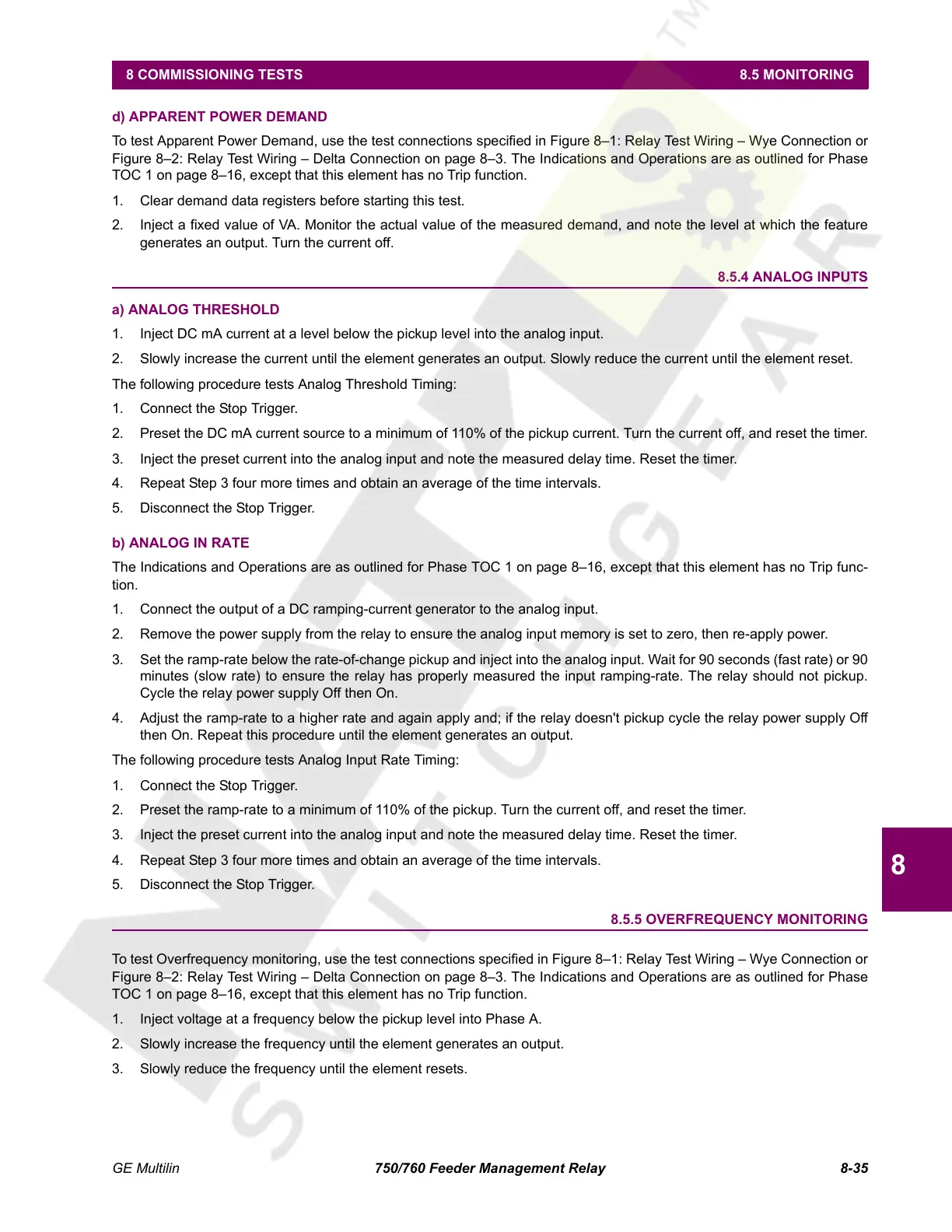GE Multilin 750/760 Feeder Management Relay 8-35
8 COMMISSIONING TESTS 8.5 MONITORING
8
d) APPARENT POWER DEMAND
To test Apparent Power Demand, use the test connections specified in Figure 8–1: Relay Test Wiring – Wye Connection or
Figure 8–2: Relay Test Wiring – Delta Connection on page 8–3. The Indications and Operations are as outlined for Phase
TOC 1 on page 8–16, except that this element has no Trip function.
1. Clear demand data registers before starting this test.
2. Inject a fixed value of VA. Monitor the actual value of the measured demand, and note the level at which the feature
generates an output. Turn the current off.
8.5.4 ANALOG INPUTS
a) ANALOG THRESHOLD
1. Inject DC mA current at a level below the pickup level into the analog input.
2. Slowly increase the current until the element generates an output. Slowly reduce the current until the element reset.
The following procedure tests Analog Threshold Timing:
1. Connect the Stop Trigger.
2. Preset the DC mA current source to a minimum of 110% of the pickup current. Turn the current off, and reset the timer.
3. Inject the preset current into the analog input and note the measured delay time. Reset the timer.
4. Repeat Step 3 four more times and obtain an average of the time intervals.
5. Disconnect the Stop Trigger.
b) ANALOG IN RATE
The Indications and Operations are as outlined for Phase TOC 1 on page 8–16, except that this element has no Trip func-
tion.
1. Connect the output of a DC ramping-current generator to the analog input.
2. Remove the power supply from the relay to ensure the analog input memory is set to zero, then re-apply power.
3. Set the ramp-rate below the rate-of-change pickup and inject into the analog input. Wait for 90 seconds (fast rate) or 90
minutes (slow rate) to ensure the relay has properly measured the input ramping-rate. The relay should not pickup.
Cycle the relay power supply Off then On.
4. Adjust the ramp-rate to a higher rate and again apply and; if the relay doesn't pickup cycle the relay power supply Off
then On. Repeat this procedure until the element generates an output.
The following procedure tests Analog Input Rate Timing:
1. Connect the Stop Trigger.
2. Preset the ramp-rate to a minimum of 110% of the pickup. Turn the current off, and reset the timer.
3. Inject the preset current into the analog input and note the measured delay time. Reset the timer.
4. Repeat Step 3 four more times and obtain an average of the time intervals.
5. Disconnect the Stop Trigger.
8.5.5 OVERFREQUENCY MONITORING
To test Overfrequency monitoring, use the test connections specified in Figure 8–1: Relay Test Wiring – Wye Connection or
Figure 8–2: Relay Test Wiring – Delta Connection on page 8–3. The Indications and Operations are as outlined for Phase
TOC 1 on page 8–16, except that this element has no Trip function.
1. Inject voltage at a frequency below the pickup level into Phase A.
2. Slowly increase the frequency until the element generates an output.
3. Slowly reduce the frequency until the element resets.
Courtesy of NationalSwitchgear.com

